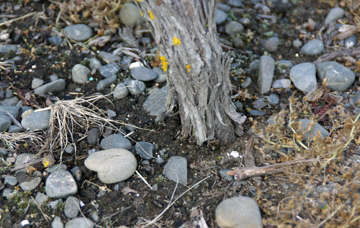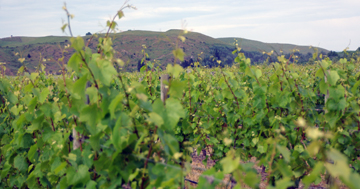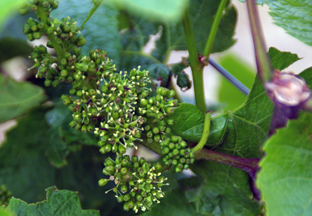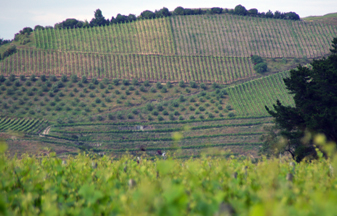Gimblett Gravels
by
Terry Sullivan
 A barren almost gravel-like landscape covers 800 hectares (almost 2,000 acres) of land in the Hawke's Bay area of New Zealand. The name derives from the gravely soils that make flora difficult to grow in this area. Three acres are needed to produce enough vegetation to feed one sheep.
A barren almost gravel-like landscape covers 800 hectares (almost 2,000 acres) of land in the Hawke's Bay area of New Zealand. The name derives from the gravely soils that make flora difficult to grow in this area. Three acres are needed to produce enough vegetation to feed one sheep.
For thousands of years the Ngaruroro River laid down a bed of gravel over the region. An 1870’s earthquake contained the course of three rivers in the area and exposed the gravels. There have been enterprising attempts to use the land. Unfortunately they became so problematic that it became difficult to even give the land away. Then in the late 1970’s the first modern era grapevines were planted. Chenin Blanc and Muller Thurgau ripened early and had higher sugar levels than other growing areas. Vinifera followed in 1981 with plantings of Merlot, Cabernet Sauvignon and Chardonnay. By the mid 1980’s wines were being produced made with grapes grown in the gravels. These wines started winning awards and people took notice. The barren Gimblett Gravels region became alive.
 In the 1990’s there was a planting boom. Larger wineries such as Villa Maria, Delegat’s and Babich began acquiring land and planting grapevines. Land that at one time couldn’t be given away became premium and now is under vine.
In the 1990’s there was a planting boom. Larger wineries such as Villa Maria, Delegat’s and Babich began acquiring land and planting grapevines. Land that at one time couldn’t be given away became premium and now is under vine.
Today, 80 percent of the area is planted with red grape varieties. The largest planting is Merlot followed by Cabernet Sauvignon, Syrah, Malbec and Cabernet Franc. There are smaller plantings of other varieties such as Gamay Noir, Montepulciano, Petit Verdot, Pinot Noir, Pinotage, Sangiovese, and Tempranillo. White grape varieties comprise 20 percent of the district with Chardonnay and Sauvignon Blanc having the largest plantings. There are smaller plantings of Arneis, Gewürztraminer, Pinot Gris, Riesling and Viognier.
 Grape Growing
Grape Growing
We met Rod Easthope, winemaker for Craggy Range at their vineyard and winemaking site in Gimblett Gravels. Craggy Range planted 100 hectares (247 acres) of grapes. Rod mentioned that when Hawke’s Bay region vineyards have a great growing season, all the vineyards have a great season, however when the growing season in the region is not great, Gimblett Gravels still has a great season.
Standing next to the Chardonnay block we learned that the layer of gravel is 60 meters (almost 200 feet) deep. Grapevines are deep rooted as they search for water. This lack of soil does require nutrients for the grapes to produce. The gravels do not hold water or minerals to meet the needs of vines. Compost is added to the top of the gravel forming a layer of humus. Growers have to add phosphate and other nutrients such as a magnesium spray. As the composted level build up topsoil, fewer nutrients will be added in the future. Likewise as the vines produce deeper roots, less irrigation is needed.
In much of the world, terroir is often defined as what is happening below the ground. In the case of Gimblett Gravels, terroir also includes the story of what is happening above the ground.
We had an opportunity to taste a 2009 Chardonnay harvested from the block of Chardonnay we were standing in. The wine was in tanks not yet bottled. The light straw colored Chardonnay offered a fruit salad aroma and taste with only a slight hint of oak. The crisp finish ended with citrus notes.
 Gimblett Gravels Winegrowers Association
Gimblett Gravels Winegrowers Association
The association was formed to define and trademark the Gimblett Gravels Winegrowing District. Rather than following political boundaries, the association defined the appellation based on soil type. The Gimblett Gravels' name may only be used on wines produced in the defined area. From the Graggy Range Chardonnay block, one can see grapevines on the hillside in the distance. Grapes grown on the hillside are not in the Gimblett Gravels appellation since their soil is different.
In a land that no one wanted, grapevines found a home. As you drive through the area, you’ll notice signs marking the Gimblett Gravels appellation. An enjoyable way to experience the Gimblett Gravels area is riding a bike along the roads.
